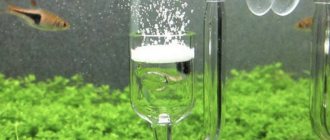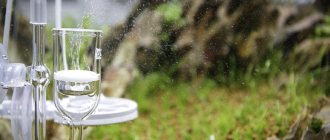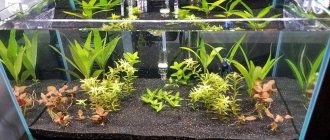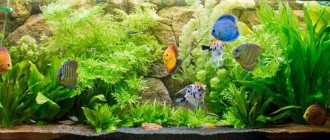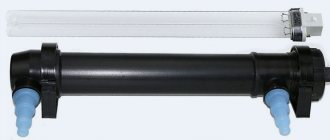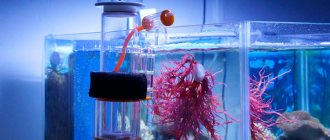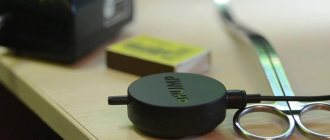Gravity CO2 generator for aquarium
You can skip the introduction and experiments and go straight to the description of the design of the Cyclic Gravity Generator. This is the best option for today.
Lately the plants in my aquarium haven't been growing well. Vallisneria barely survives. Cryptocoryne and similar plants reproduce so slowly that all the leaves have time to grow a black beard.
Once I already had an aquarium with lush green plants without black beard or thread.
- The aquarium stood on the windowsill.
- The four of us lived in one room in a communal apartment.
For these two reasons, there was a lot of light and carbon dioxide.
I recently replaced the fluorescent lamps with LED lamps 2 x 30 W in a 200 liter aquarium and 2 x 20 W in a 100 liter aquarium. Now, when illuminated, oxygen bubbles rise from the plants. New leaves began to appear more often.
It's time to add CO2
I am not going to create a “Dutch” aquarium or a “herbalist”. I am satisfied with the more or less natural biological balance in the aquarium.
Suppressing algae and unruly plants that require weeding is not a balance, but a special hobby. I'm interested in using a new type of lamp and a homemade CO2 generator to see what happens.
This is not an aquarium interest, but an engineering interest. Just curiosity.
Bottled CO2 supply seems complicated. This is for professionals with beautiful large underwater gardens. I'm still a long way from that. It’s easier for beginners to start with a brew generator
. I once tried making CO2 from sugar and yeast.
yeast CO2 generator circuit
The experiment was stopped because it was inconvenient to switch the tap every morning and evening so that carbon dioxide was supplied only when there was light. I also didn't like the smell of yeast.
The sugar and yeast generator is a one-component one, and therefore the design is simple. Carbon dioxide is released rapidly at first, then more and more slowly. The operating time of one gas station is approximately a week.
Since then, solenoid valves have appeared to automate gas supply. A two-component CO2 generator without yeast was invented using citric acid and soda.
Homemade people make carbon dioxide generators not only for aquariums. CO2 on the windowsill improves the growth of indoor flowers. CO2 is used in advanced mosquito traps.
Chemistry
In the presence of water, citric acid [C6H8O7] and baking soda [NaHCO3] react to produce sodium citrate [Na3C6H5O7], water and carbon dioxide.
Reaction equation: C6H8O7 + 3NaHCO3 (acid + soda in water) ► Na3C6H5O7 + 3H2O + 3CO2 (salt water gas) without water the reaction does not occur
1 mole (192 grams) of citric acid produces 3 moles of carbon dioxide. The resulting mass of CO2 is 3×44 = 132 grams, volume – 66 liters.
All components involved in the chemical reaction (soda, citric acid, sodium citrate, water and carbon dioxide) are quite safe and can be used for cooking.
A little educational program. About photosynthesis.
As you know, almost all substances that make up any living organism (proteins, fats, carbohydrates, nucleic acids, etc.) consist of 99% of only three chemical elements: carbon, oxygen and hydrogen. The remaining 1% consists of macroelements: nitrogen, phosphorus and potassium, as well as the so-called “microelements” (primarily iron, calcium, magnesium, zinc, and others in smaller quantities - almost half of the periodic table). Green plants have an amazing mechanism that allows them to independently synthesize organic substances from carbon dioxide and water. Under the influence of sunlight, a special substance contained in their cells - the green pigment chlorophyll - produces simple sugar - glucose - from CO2 and H2O, and from it, with the help of macro- and microelements, enzymes can make proteins, fiber, starch and everything else that needed for the construction of a plant organism. During this reaction, oxygen is released into the environment. Plants use a small part of this oxygen for respiration, and the rest is released into the air or water.
So, for normal growth and development of higher green plants, a sufficient amount is necessary:
- carbon dioxide;
- water;
- sunlight;
- macroelements (nitrogen, phosphorus, potassium);
- microelements (iron, calcium, magnesium, zinc, etc.)
All these components must be balanced with each other. A deficiency or excess of any of them immediately gives advantages not to higher plants, but to harmful parasitic algae (green filamentous algae, scarlet algae, diatoms and others), which create problems in the aquarium. These organisms, which are millions of years older than flowering plants, are adapted to any conditions. For example, if your aquarium has a lot of light and little CO2, you give an advantage to filamentous algae, which can quickly fill your aquarium with tangled fibers of mud. What can be done to prevent this from happening?
In chemistry and biochemistry there is such a concept - “reaction limiting factor”. What this is is well understood by those who often go hiking: the speed of the group is always equal to the speed of the slowest of its members, who is the “limiting factor.” The same applies to the growth of aquarium plants. They have enough water in abundance (they live in it!), macro- and microelements come from the soil, from water and with the application of fertilizers, making good bright lighting is also not a problem, but difficulties arise from time to time with CO2. This is what becomes the “limiting factor” in the aquarium. Why? Why do carbon dioxide problems occur in an aquarium but not in nature? Let's figure it out...
Control and measurement equipment
To effectively saturate water with carbon dioxide, you must know its current level. Having this data, it is very easy to adjust the gas level and bring it back to normal. Among such devices are:
- Dropchecker . This is a container, one part of which is filled with a standard solution for measuring carbonate hardness, and the second with the same substance, but for determining pH. There is always a layer of air between them, which prevents mixing.
- Bubble counter . It is a transparent flask containing water. On both sides it is embedded in a tube through which carbon dioxide flows. The feed rate actually depends on the interval at which neighboring bubbles in the water enter the counter. This is the most obvious example of how you can observe the degree of saturation.
In addition, you can separately measure all the indicators that the drop checker shows and use a table that shows the relationship between the two values and the CO2 concentration. There are also online calculators that do all the calculations automatically. The only thing to consider is the time period for which the calculation is performed.
There is another method, but it is intended for very experienced people who maintain their aquariums in good condition. This is a definition “by eye”, but the specialist takes into account such factors as the illumination of the water column and the rate of bubble release. You also need to know at least approximately the gas concentration in the aquarium at the time of measurement.
Then, from one observation of how quickly bubbles are released, a specialist can tell how much the carbon dioxide content will change over any time period. The danger of such a calculation is that it is impossible to know how much biomass is in the tank, since reproduction is constantly going on in it. As a result, you can greatly miscalculate, especially if you do not know the approximate gas production of each type of flora.
Carbon dioxide production equipment
Device
To create the device you will need two plastic bottles with caps. We make 2 holes in the caps into which the tubes will be placed. One tube serves as a connector between two containers.
The second hole is necessary for a tee with tubes. One of the tubes will go into the container with the fish. In the middle of the tee it is necessary to place a tap to regulate the gas flow.
To uninterruptedly supply CO2 to the fish with your own hands, you need a CO2 generator. The CO2 generator is responsible for the degree of carbon supply.
You can make your own CO2 bubble counter from a syringe.
CO2 reactor
The reagents for the manufactured apparatus are soda and citric acid. In one bottle we place a solution of 100 grams of water and 60 grams of soda, and in the second – 50 grams of citric acid dissolved in 100 grams of water. Be sure to seal the bottle caps tightly.
We dip the ends of the tubes into solutions that are produced by mixing co2 in an aquarium. The gas passes through the tee to aquarium fish and plants. Before using reagents, it is recommended to check the device for leaks to prevent gas leakage.
